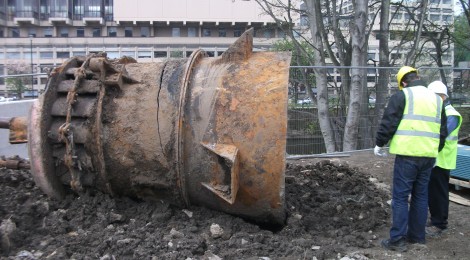
Durham’s Icy Past
We have a constant flow of donations coming into the museum, however, this week we had some more unusual items to add to the museums vast collection.
Any regular visitors to Durham City will have no doubt noticed that the site of the former Ice Rink is currently being redeveloped. Most of the ice rink building was relatively modern construction except for the remnants of the Bishops Mill.
The first documented evidence for a Bishops Mill in Durham is in the Boldon Book of 1183, however, this was probably on a different site to the current building. For most of the time the mills history it was used for grinding corn until the late 19th century. Latterly, the mill was used for crushing various tropical hardwoods. This was carried out to release chemical used in fabric dyes in the local textile industry.
During the 20th century, as most of Durham’s mills had fallen out of use, Bishops Mill was given new lease of life by local businessman John Smith. Smith, born in Barnard Castle in 1889, spent a short time in his family’s metal business before he set about establishing his own business.
Rather than continuing with metal work John branched out into, the rather more obscure trade of, ice production. In the pre refrigeration age ice was an important commodity for grocer’s fish mongers and butchers. Ice also came with the advantage of having to be replenished on a daily basis.
The ice business was originally established in Darlington, where Smith also became Mayor. Then, in the early 1930s, the business was moved to Bishop’s Mill.
The mill site was chosen for the ice factory as the River Wear was the ideal power source for the refrigeration machinery. Hydro-electric generation, now though of as a modern ‘green’ method of power generation, was utilised by Smith to great effect.
Unfortunately, the enterprise was short lived as by the end of the 1930s the rapid growth in home and commercial refrigeration spelled the end for the Durham Ice Factory. However, Mr Smith was not about to waste his investment in the ice making plant. So, in 1939 the idea for the Durham Ice Rink was born.
However, with the outbreak of war the project quickly came to a halt. With refrigeration equipment already installed, a large marquee was used to cover the half finished rink. Even though the rink was unfinished members of the Royal Canadian Air Force stationed in the area regularly took to the ice to play hockey.
After the end of the War building work on a permanent building was completed and the rink became a regular haunt for generations of Durham residents along with the Durham Wasps, Durham’s own Ice Hockey team, formed by Smith himself.
Now the site is being redeveloped, for housing and offices, the ice making machinery has had to be removed to make way for the developments along with the installation of a new Hydro-electric generator.
As we only have the Beamish Burn running through the museum site, we may not have the water power to turn these huge turbines but they are a fascinating collection of Durham’s early hydro-electric power generation.












Walked past this place for years, would loved to have seen the installation as it was, really did not know the gear had been saved, pleased it has though! Great to see the David Brown gearbox, very interesting, Plus the whole thing was/is interesting for the time it was installed,I gather the turbine drove an ammonia refrigerant compressor and a generator? Amazing!! keep up the good work Beamish!!!!